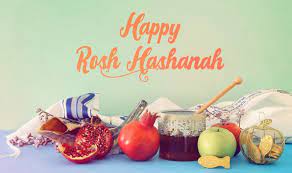Rosh Hashanah occurs on the first and second days of Tishri. Jewish Year 5782 starts at sunset on Sept.6 (The Jewish calendar date begins at sundown of the night beforehand. Thus all holiday observances begin at sundown on the secular dates listed, with the following day being the first full day of the holiday. According to the Torah, the story of creation in Genesis says “And it was evening, and it was morning day one”, “And it was evening, and it was morning; the second day”, thus night comes before day. So, for the Jewish calendar all days begin at nightfall and end the next day at nightfall including holidays.)
In Hebrew, Rosh Hashanah means, literally, “head of the year” or “first of the year.” Rosh Hashanah is commonly known as the Jewish New Year. This name is somewhat deceptive, because there is little similarity between Rosh Hashanah, one of the holiest days of the year, and the American New Year.
There is, however, one important similarity between the Jewish New Year and the American one. Many Americans use the New Year as a time to plan a better life, making “resolutions.” Likewise, the Jewish New Year is a time to begin introspection, looking back at the mistakes of the past year and planning the changes to make in the new year.
The shofar is a ram’s horn which is blown somewhat like a trumpet. One of the most important observances of this holiday is hearing the sounding of the shofar in the synagogue.
No work is permitted on Rosh Hashanah. Much of the day is spent in temple, where the regular daily liturgy is somewhat expanded. There is a special prayer book called the machzor used for Rosh Hashanah and Yom Kippur because of the extensive liturgical changes for these holidays.
The common greeting at this time is L’shanah tovah (“for a good year”). This is a shortening of “L’shanah tovah tikatev v’taihatem” which means “May you be inscribed and sealed for a good year.”
Yom Kippur, on Sept.15, also known as the Day of Atonement, is the holiest day of the year in Judaism. Its central themes are atonement and repentance. Some Jewish people traditionally observe this holy day with an approximate 25-hour period of fasting and intensive prayer, often spending most of the day in synagogue services.
Yom Kippur completes the annual period known in Judaism as the High Holy Days or Yamim Nora’im (“Days of Awe”) that commences with Rosh Hashanah.
Happy New Year to a few famous Jews:
Albert Einstein, Sigmund Freud, Karl Marx, Leon Trotsky, Harry Houdini, Marx brothers, Steven Spielberg, Sandy Koufax, Irving Berlin (Ironically, his compositions included “White Christmas” and “Easter Parade”) ,Mel Brooks, Dustin Hoffman, Peter Sellers, Al Jolson, Stan Getz, Ruth Ginsburg and Mark Zuckerberg (and Jesus Of Nazareth of course).

